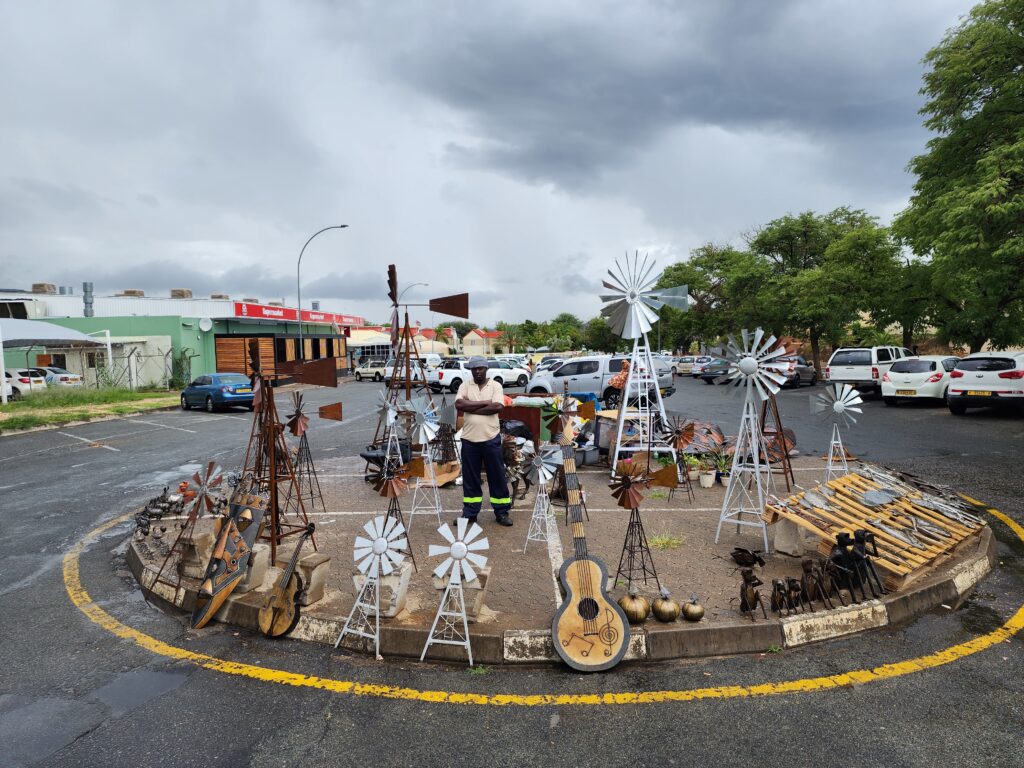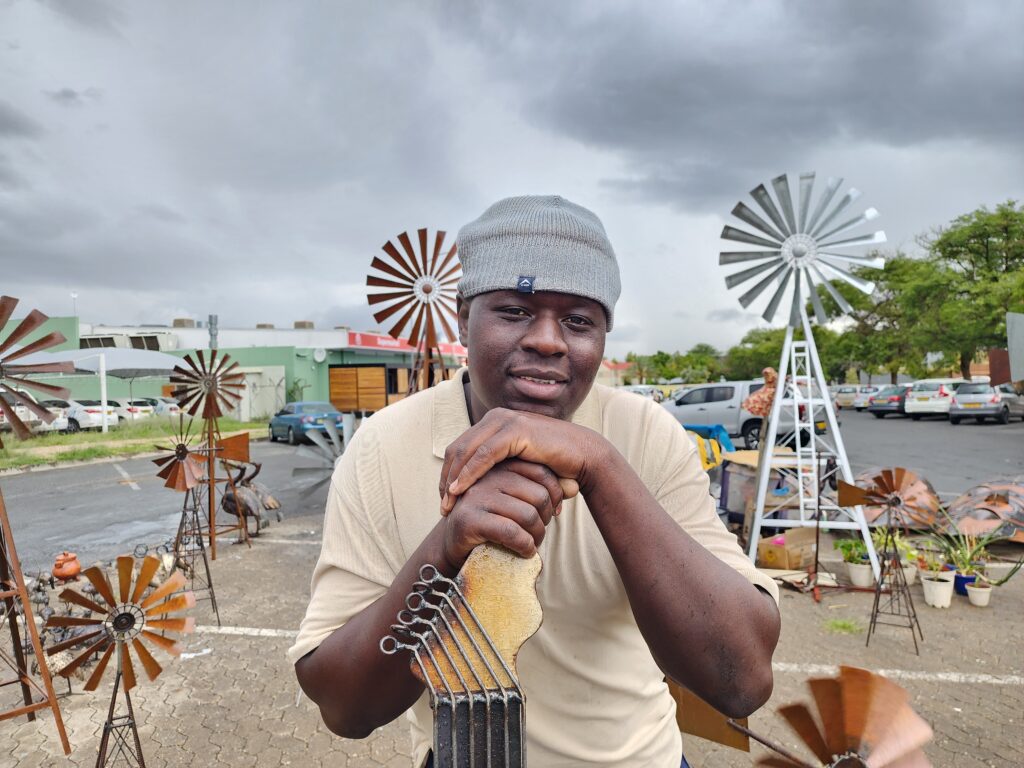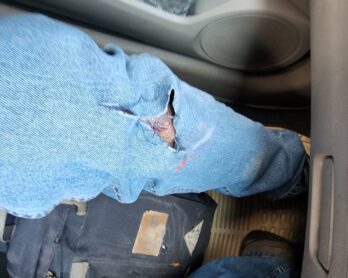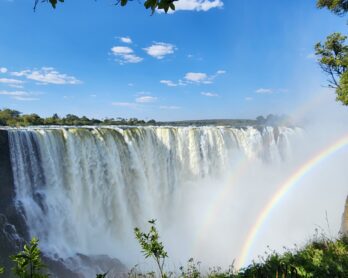Vincent came running.
“I was in that house cleaning their swimming pool,” he said pointing and with a broad smile I had gotten used to in Africa by now. “The rain and the wind had mucked it up,” he added, swole in damp clothes and wiping off drizzle from his face. The woollen cap was left on.
This was my third visit to the Namibian capital, Windhoek, and I had passed through the ‘art island’ – as I referred to the area in the carrefour near a parking lot where Vincent had set up shop – umpteen times on my way to the supermarket nearby. Sometimes I would see Vincent working on something, never hustling or even looking at passers-by, but mostly it would be somebody else, a pleasant harlequin, who kept an eye on the wares and hurried for him whenever anyone showed interest.
The art island had stick metal figures of the big five, insects and birds, tribal folks and flowers. There were statuettes, musical instruments – some of them working – and masks. And there were the windmills which rotated with a fury, trying to keep up with the winds Windhoek was famous for. The name of the city itself coined from, as it is widely held, two Afrikaans/Dutch word meaning ‘wind’ and ‘corner.’
I thought of Marcel Duchamp’s famous Bicycle Wheel, and kinetic art some artist friends worked in. Most of Vincent’s components were not manufactured – or ‘found’ – he did make use of some already there like the automobile bearing for the drivetrain instrumental to making the windmill turn. He made good mostly by recycling scrap, but the bearing had to be purchased from junkyards, sometimes new even, which made the windmills not exactly cheap.
“With so much wind in Windhoek, I thought it would look good – turning all the time. And it had to turn all the time.” His customers were mostly households and hotels with small acreages next to them and the quality assemblage gave him good word-of-mouth publicity. They were not exactly site-specific either, a friend brought it for her terrace where she was setting up a braai.
“Don’t they look pretty?” He asked, standing back, not puffing but critically sizing up his own handiwork. They did, even though not under warm studio lights; proud cultural ramparts beaming under the gloaming brought on by the monsoon clouds.
Vincent Karavina arrived in Namibia from Bulawayo in southwest Zimbabwe, gateway to the Matobo National Park. The Park is famous for cave art from the Stone Age. Hundreds of renditions of hunters and gatherers from thousands of years ago adorn the Inanke Caves here. A good reason why Vincent, who never had any formal initiation into art believes art runs in his blood.
“I came here because Namibia had potential in terms of less population than most other African countries.” He added that it also meant not many artists catering to a large number of tourists passing through for safaris and sightseeing. Some tour organizers I knew in Windhoek had a half to full day itinerary giving genuine art enthusiasts the opportunity to interact with artists of different styles and disciplines. This was organized and fantastic, gave artists a much-needed international exposure. But these well-meaning outfits often ignored immigrant artists like Vincent.
“I came here with proper documents and valid passports, all of which expired,” he grinned, almost laughing at fate. Vincent stayed with his wife and two kids on rent at Katutura (which means, in a local dialect, ‘the place where people do not want to live’) a suburban township of Windhoek which came up in the 60s when Africans were removed from Windhoek.
“It is not that I don’t want to renew my papers,” he said earnestly. “But when it is a call between feeding your family or getting arrested, I must say I am caught between a rock and hard place.” He laughed loudly this time, and I couldn’t help but join in making the smattering of generally prim and reticent Germans, the affluent upper crest, look at us unhappily.
In many African countries I visited there was a renewed thrust on farming with sizeable portions of national budget allocations. Though most of it was only on paper, there was a widespread recognition on the sector’s potential to reduce poverty and its impact on the political economy. Now, if the countries got around to reviving it, improving food production and job creation, would it benefit the artists? Most artists I knew personally chose to just create with their hands – and not do much else which was understandable too. But I asked Vincent this question as he was already a preferred odd-job hand in the area. While we were talking, a labour contractor came and told him to get ready the next day for some tile laying work behind the supermarket.
“We, like anybody else, need to eat, feed our families,” he replied, stern but the smile never leaving his face. “We create things with our hands, so growing things will not be difficult for us.”
This article was published by The Hindu’s Frontline magazine as Namibia: Windmills for Windhoek.















I appreciate the efforts you make to promote inclusivity and diversity in your blog. It’s refreshing to see different perspectives represented.
The narrative captures a vivid scene in Windhoek, Namibia, focusing on the artist Vincent Karavina and his unique creations on the “art island.” Here are some observations and feedback:
Descriptive Language:
The descriptive language paints a clear picture of the surroundings, Vincent’s appearance, and the atmosphere in Windhoek. It engages the reader and helps in visualizing the art island and the artist’s work.
Incorporation of Artistic References:
The reference to Marcel Duchamp’s Bicycle Wheel adds depth to the narrative, connecting Vincent’s kinetic art to established art movements. It also introduces readers to the concept of kinetic art for those unfamiliar with it.
Cultural and Historical Context:
The mention of Windhoek’s name origin and its association with winds adds a layer of cultural and historical context. It enriches the reader’s understanding of the city and its significance.
Vincent’s Background and Inspiration:
Providing insights into Vincent’s background, his migration from Zimbabwe, and the influence of Matobo National Park on his artistic inclination adds a personal touch. It helps readers understand the artist’s journey and motivations.
Social and Economic Challenges:
Vincent’s candid discussion about the challenges he faces, such as expired documents and the struggle to balance family needs with legal issues, adds a human element to the story. It sheds light on the socio-economic realities faced by immigrant artists.
Humor and Resilience:
Vincent’s humor and resilience, as seen in his laughter despite challenges, create a likable and relatable character. It adds warmth to the narrative and makes Vincent more than just an artist but a person facing everyday struggles.
Engagement with Larger Questions:
The narrative briefly touches upon larger questions related to farming, food production, and job creation in Africa. While not delving deep into these topics, it hints at the broader socio-economic context that artists like Vincent navigate.
Visual Appeal:
The mention of windmills, stick metal figures, and other art installations creates a visual appeal. Readers can imagine the vibrant and dynamic art scene on the “art island.”
Ending with a Question:
Ending with the question about whether reviving farming would benefit artists adds a thoughtful element. It invites readers to reflect on the interconnectedness of different sectors and their impact on the arts.
Overall, the narrative successfully combines storytelling, cultural insights, and a glimpse into the life of an immigrant artist in Windhoek. It effectively captures the resilience and creativity of individuals like Vincent who contribute to the local art scene despite facing challenges.
Your travel adventures are an absolute inspiration! Your ability to capture the beauty of each destination and share it through your words and photos is truly remarkable. I’m constantly in awe of the way you bring the world to life with your storytelling. Keep spreading those good vibes and wanderlust!

 #TravelGoals #AdventureAwaits
#TravelGoals #AdventureAwaits
https://seafriends.sg/